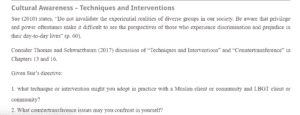Cultural Awareness
Techniques and Interventions
Discrimination against some marginalized groups has been an issue in our societies worldwide. Discrimination based on skin color, sexual preference, and religion is a challenge that most people face. This discrimination leads to issues such as anxiety and depression that push some people to seek professional help by seeing counselors or therapists (Wing Sue, 2010). A counselor should be prepared to help such people without letting their beliefs interfere with the session and face their countertransference. Different intervention techniques applied with such clients include assisting the client in process identity, acculturation, and intersectionality (Thomas and Schwarzbaum, 2017).
What technique or intervention might you adopt in practice with a Muslim client or community and LBGT client or community?
The first technique to adopt when seeing a Muslim or LGBT client or community would be helping the client process identity (Thomas and Schwarzbaum, 2017). I would sensitively assist the client in understanding how they feel about their religion, culture, and sexual orientation. Also, I would assess for any shame and internal judgment the LGBT client might be feeling and help them understand these feelings till they accept themselves for who they are.
The second intervention technique is acculturation and intersectionality (Thomas and Schwarzbaum, 2017). The technique entails understanding the client’s culture, religion, and sexual orientation and how they relate to their immediate society cultures. Therefore, it will identify previous discrimination and oppression and help counsel the client about it by affirming it and providing empathy. Besides that, I would help the clients impersonalize their encounters to protect themselves from microaggressions.
What countertransference issues may you confront in yourself?
Countertransference issues that would come up with Muslim or LGBT clients or communities would be confusion, fear, and anxiety. I would have feelings of fear and anxiety with the Muslim client because of misunderstanding about their religion, which would be rectified by reading about and understanding the Muslim religion. With the LGBT client, I would be aware of my opinion on their sexuality and choices and prevent imposing my opinion on them.
To conclude, discrimination cases are apparent in our day-to-day lives, and how we choose to deal with them varies. Since most discrimination cases are imposed on people of color, Muslim religion, and the LGBT community, they turn to therapy to help them understand their experiences. Through therapy, counselors can help their clients better understand themselves and their societies.
References
Sue, D., 2010. Microaggressions In Everyday Life: Race, Gender, and Sexual Orientation. John Wiley & Sons, Inc.
Thomas, A. and Schwarzbaum, S., 2017. Culture and Identity: Life Stories for Counselors and Therapists. 3rd ed. Sage Publishers.
ORDER A PLAGIARISM-FREE PAPER HERE
We’ll write everything from scratch
Question
Cultural Awareness – Techniques and Interventions
Sue (2010) states, “Do not invalidate the experiential realities of diverse groups in our society. Be aware that privilege and power oftentimes make it difficult to see the perspectives of those who experience discrimination and prejudice in their day-to-day lives” (p. 60).

Cultural Awareness
Consider Thomas and Schwarzbaum (2017) discussion of “Techniques and Interventions” and “Countertransference” in Chapters 13 and 16.
Given Sue’s directive:
- what technique or intervention might you adopt in practice with a Muslim client or community and LBGT client or community?
- What countertransference issues may you confront in yourself?

